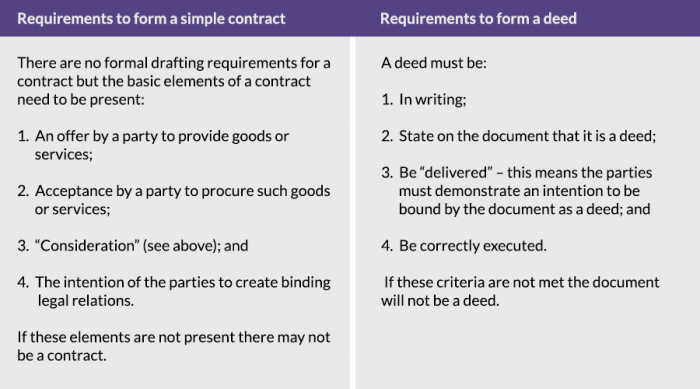Signing a deed or a contract should be the easiest part of any transaction or project. Once complex negotiations have been concluded and the commercial terms have been agreed, all that is left to do is for the parties to sign on the dotted line. This sounds simple but we routinely find that documents have been incorrectly executed on construction projects.
Why does it matter?
Legal documents are generally drafted as either a contract or a deed.
The key difference between a deed and contract relates to the period in which a party can bring a claim against the other:
- Deeds can be enforced for 12 years from the date of the breach of the obligation contained in the deed; and
- Contracts can be enforced for 6 years from the date of the breach of contract.
Deeds are more commonly used in the construction industry because it may take several years for a defect to become apparent.
If a document that is intended to be a deed has not been properly executed as a deed, that document may actually be a contract, in which case you will have a shorter time in which to bring a claim in the event defects appear once a project has been completed.
Worse still, an incorrectly executed deed may not even be enforceable as a contract. As set out below, a contract requires “consideration”. Deeds do not always include a consideration provision and so if a deed has been invalidly executed (for example, one of the requirements of a deed set out in the table below is missing), it may be unenforceable as a contract owing to the lack of a consideration provision. In the context of collateral warranties and letters of reliance where only one party is providing consideration, this can render the warranty worthless.
This can have serious consequences, for example if you need to seek funding in relation to a project and the documents have been incorrectly executed. You may find that a funder is unwilling to provide any funding for the project as their ability to recover under the construction documents in the event something goes wrong has been compromised.
It is important to ensure that certain requirements are met and that documents are properly signed. So, how do we get it right?

The Difference Between Deeds & Contracts
There are two important elements relating to the correct execution of deeds and contracts:
1) certain drafting requirements; and
2) the signing of the documents.
Drafting requirements
The table below sets out the drafting requirements of contracts and deeds:

Signature requirements
Both contracts and deeds can be signed by a company in the following ways:
- affixing the company seal; or
- by signature of two company directors; or
- by signature of a company director and the company secretary; or
- by signature of a company director in the presence of a witness.
Whilst electronic signatures are becoming a popular way of signing certain documents, the construction industry generally and funders of construction projects tend to favour “wet ink” signatures (i.e. each party physically signs each counterpart copy of each document). For simple contracts, execution signatures may not be required.
Avoiding mistakes
In summary, there is more to executing documents than may seem the case and the consequences of incorrect execution can be significant.
Seeking legal advice well in advance of the point of signing construction documents should be on all developers’ to do lists, whether your project involves the construction of a single dwelling or a large commercial development.
At Myerson, our Construction Team can offer advice on all aspects of contentious and non-contentious matters. For more information on the range of legal services Myerson LLP can provide please call Myerson’s Construction Team on 0161 941 4000 or email lawyers@myerson.co.uk.
